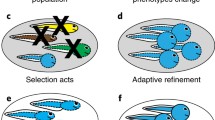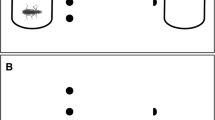Abstract
Identifying the environmental mechanism(s) controlling developmental polyphenism is the first step in gaining a mechanistic and evolutionary understanding of the factors responsible for its expression and evolution. Tadpoles of the spadefoot toad Spea multiplicata can display either a “typical” omnivorous or a carnivorous phenotype. Exogenous thyroxine and feeding on conspecific tadpoles have been accepted as triggers for development of the carnivorous phenotype on the basis of a series of studies in the early 1990s. I repeated the thyroxine and conspecific-feeding assays and demonstrated that neither exogenous thyroxine nor feeding on conspecifics induces the carnivorous phenotype. Previous researchers used simple ratio statistics to argue that field-collected carnivores and thyroxine-treated tadpoles are similar, and my results supported these claims if I used the same simple ratio methodology. However, investigation of trait developmental trajectories and allometries for field-collected carnivores and thyroxine-treated and conspecific-fed tadpoles show that these phenotypes are profoundly different.





Similar content being viewed by others
References
Alford RA (1999) Ecology: resource use, competition, and predation. In: McDiarmid RW, Altig R (eds) Tadpoles: the biology of anuran larvae. University of Chicago Press, Chicago, pp 240–278
Beachy CK (2001) Effects of growth history and exogenous thyroxine on size and age at metamorphosis in the toad Bufo americanus. Copeia 2001:829–834
Begun DJ, Collins JP (1992) Biochemical plasticity in the Arizona tiger salamander (Ambystoma tigrinum nebulosum). J Hered 83:224–227
Blouin MS, Brown ST (2000) Effects of temperature-induced variation in anuran larval growth rate on head width and leg length at metamorphosis. Oecologia 125:358–361
Brakefield PM, Mazzotta V (1995) Matching field and laboratory environments: effects of neglecting daily temperature variation on insect reaction norms. J Evol Biol 8:559–573
Brakefield PM, Kesbeke F, Koch PB (1998) The regulation of phenotypic plasticity of eyespots in the butterfly Bicyclus anynana. Am Nat 152:853–860
Buchholz DR, Hayes TB (2000) Larval period comparison for the spadefoot toads Scaphiopus couchii and Spea multiplicata (Pelobatidae: Anura). Herpetologica 56:455–468
Buchholz DR, Hayes TB (2002) Evolutionary patterns of diversity in spadefoot toad metamorphosis (Anura: Pelobatidae). Copeia 1:180–189
Das B, Schreiber AM, Huang H, Brown DD (2002) Multiple thyroid hormone-induced muscle growth and death programs during metamorphosis in Xenopus laevis. Proc Natl Acad Sci USA 99:12230–12235
Denver RJ (1993) Acceleration of anuran amphibian metamorphosis by corticotropin-releasing hormone-like peptides. Gen Comp Endocrinol 91:38–51
Denver RJ (1997) Environmental stress as a developmental cue: corticotrophin-releasing hormone is a proximate mediator of adaptive phenotypic plasticity in amphibian metamorphosis. Horm Behav 31:169–179
Denver RJ (1998) Hormonal correlates of environmentally induced metamorphosis in the western spadefoot toad Scaphiopus hammondii. Gen Comp Endocrinol 110:326–336
Emlen DJ (1994) Environmental control of horn length dimorphism in the beetle Onthophagus acuminatus (Coleoptera: Scarabaeidae). Proc R Soc Lond B Biol Sci 256:131–136
Frieden E (1961) Biochemical adaptation and anuran metamorphosis. Am Zool 1:115–149
Frieden E, Just JJ (1970) Hormonal responses in amphibian metamorphosis. In: Litwack G (ed) Biochemical actions of hormones. Academic, New York, pp 1–52
Gilbert SF (2003) Developmental biology. Sinauer, Sunderland
Gosner KL (1960) A simplified table for staging anuran embryos and larvae with notes on identification. Herpetologica 16:183–190
Greene E (1989) A diet-induced developmental polymorphism in a caterpillar. Science 243:643–646
Harkey GA, Semlitsch RD (1988) Effects of temperature on growth, development, and color polymorphism in the ornate chorus frog Pseudacris ornata. Copeia 1988:1001–1007
Hoffman EA, Pfennig DW (1999) Proximate causes of cannibalistic polyphenism in larval tiger salamanders. Ecology 80:1076–1080
Kaltenbach JC (1970) Local metamorphic action of thyroxine analogues in Rana pipiens larvae. J Exp Zool 174:55–64
Ketterson ED, Nolan V Jr (1999) Adaptation, exaptation, and constraint: a hormonal perspective. Am Nat 154:S4–S25
Kollros JJ (1961) Mechanisms of amphibian metamorphosis: hormones. Am Zool 1:107–114
Kupferberg SJ (1997) The role of larval diet in anuran metamorphosis. Am Zool 37:146–159
Moczek AP, Emlen DJ (1999) Proximate determination of male horn dimorphism in the beetle Onthophagus taurus (Coleoptera: Scarabaeidae). J Evol Biol 12:27–37
Newman RA (1987) Effects of density and predation on Scaphiopus couchii tadpoles in desert ponds. Oecologia 71:301–307
Newman RA (1994) Effects of changing density and food levels on metamorphosis of a desert amphibian, Scaphiopus couchii. Ecology 75:1085–1096
Newman RA (1998) Ecological constraints on amphibian metamorphosis: interactions of temperature and larval density with responses to changing food levels. Oecologia 115:9–16
Pfennig DW (1990) The adaptive significance of an environmentally-cued developmental switch in an anuran tadpole. Oecologia 85:101–107
Pfennig DW (1992a) Proximate and functional causes of polyphenism in an anuran tadpole. Funct Ecol 6:167–174
Pfennig DW (1992b) Polyphenism in spadefoot toad tadpoles as a locally adjusted evolutionary stable strategy. Evolution 46:1408–1420
Pfennig DW, Murphy PJ (2000) Character displacement in polyphenic tadpoles. Evolution 54:1738–1749
Pomeroy LV (1981) Developmental polymorphism in the tadpoles of the spadefoot toad, Scaphiopus multiplicata. PhD dissertation, University of California
Rugh R (1962) Experimental embryology. Burgess, Minneapolis, pp 315–322
Semlitsch RD, Caldwell J (1982) Effects of density on growth, metamorphosis, and survivorship in tadpoles of Scaphiopus holbrooki. Ecology 63:905–911
Shaffer HB, Voss SR (1996) Phylogenetic and mechanistic analysis of a developmentally integrated character complex: alternate life history modes in ambystomatid salamanders. Am Zool 36:24–35
Sokal RR, Rohlf FJ (1995) Biometry. Freeman, New York
Steinwascher K, Travis J (1983) Influence of food quality and quantity on early larval growth of two anurans. Copeia 1983:238–242
Travis J (1980) Phenotypic variation and the outcome of interspecific competition in hylid tadpoles. Evolution 34:40–50
Travis J, Trexler JC (1986) Interactions among factors affecting growth, development, and survival in experimental populations of Bufo terrestris (Anura, Bufonidae). Oecologia 69:110–116
Van Buskirk J, McCollum SA (1999) Plasticity and selection explain variation in tadpole phenotype between ponds with different predator composition. Oikos 85:31–39
Van Buskirk J, McCollum SA (2000) Functional mechanisms of an inducible defence in tadpoles: morphology and behaviour influence mortality risk from predation. J Evol Biol 13:336–347
Whiteman HH (1994) Evolution of facultative paedomorphosis in salamanders. Q Rev Biol 69:205–221
Acknowledgements
Many thanks to Joseph Travis, Anne B. Thistle, Alice A. Winn, Shonna R. Storz, Gregory M. Erickson, Scott J. Steppan, Thomas A. Houpt, and four anonymous reviewers for reviews, comments, and constructive criticism. Thanks to the resident scientists, staff, and volunteers at the Southwestern Research Station (American Museum of Natural History). This research was supported by the Theodore Roosevelt Memorial Fund (AMNH), Sigma Xi, and the Robert B. Short Fellowship (FSU). Collecting permit: Arizona SP710791, Florida not required. All laboratory research was conducted under ACUC protocol 0020 from Florida State University.
Author information
Authors and Affiliations
Corresponding author
Rights and permissions
About this article
Cite this article
Storz, B.L. Reassessment of the environmental mechanisms controlling developmental polyphenism in spadefoot toad tadpoles. Oecologia 141, 402–410 (2004). https://doi.org/10.1007/s00442-004-1672-6
Received:
Accepted:
Published:
Issue Date:
DOI: https://doi.org/10.1007/s00442-004-1672-6




